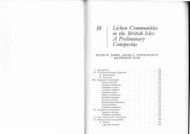Create successful ePaper yourself
Turn your PDF publications into a flip-book with our unique Google optimized e-Paper software.
cup ends, with or without squamules or<br />
projecting lamellae Cladonia<br />
21 Thallus on lime-rich rocks, usually brown to<br />
black, also whitish pruinose, with bluegreen<br />
algae. . . GS Polychidium<br />
(If gray to (gray)brown, underside whitish to<br />
slightly brownish, with flattened, -0.3 mm wide<br />
marginal granular segments, with isolated<br />
rhizines, with green algae<br />
↑. Phaeophyscia nigricans)<br />
21* Not on limestone 22<br />
22 Thallus white, gray, olive, occasionally lightly<br />
browned 23<br />
22* Thallus brown, dark brown, black, gray-black 30<br />
23 Thallus segment clearly wider than thick, band<br />
like flattened to channeled, ± branched . 24<br />
23* Thallus segment/branch ± cylindrical to weakly<br />
flattened, scarcely wider than thick 27<br />
24 Thallus ± erect on peat, 2-6 cm, segments clearly<br />
channeled, flattened toward the ends, on one side<br />
bright brown to olive, on the other side usually<br />
lighter, brownish-white, olive-white, with<br />
numerous occurring whitish pseudo-cyphellae,<br />
the margins covered with small teeth, reddish at<br />
the base . Cetraria islandica<br />
24* Thallus whitish to gray, if gray-brown, then<br />
finely velvety (hand lens), base not reddish. . 25<br />
25 Thallus segment with isolated stiff whitish to<br />
dark cilia or bristles on the lobe ends<br />
occasionally marginal, usually with terminal lip<br />
or helmet-form soralia or with ap. Often loosely<br />
attached, not spreading, not pendent<br />
GS Physcia<br />
25* Thallus segment without such cilia, narrowly to<br />
broadly band like, ± forked, somewhat enrolled<br />
at the sides, therefor the underside slightly<br />
channeled. Ap. very rare 26<br />
26 Thallus ± thickly covered with cylindrical isidia,<br />
gray, underside <strong>of</strong> the younger parts whitish to<br />
rose, the older parts dull blue-blackish to black,<br />
forked branching, very variable, up to over 10 cm<br />
long . Lobes 1-5 mm wide .<br />
Pseudevernia furfuracea<br />
26* Thallus without cylindrical isidia, with soralia at<br />
the margins and/or on the surface, gray, <strong>of</strong>ten<br />
with slightly unevenness, undersides whitish,<br />
usually to 5 cm long. Lobes 1-3 mm wide<br />
Evernia prunastri var. herinii<br />
(if the undersides black or brown, segments<br />
strongly protruding, but foliose: GS Cetraria)<br />
27 Thallus thread-like, ± richly branching, pendent<br />
or decumbent, <strong>of</strong>ten ± beard-like, whitish, beige,<br />
gray, gray-brown, or olive. Threads commonly<br />
0.3-1 mm thick, not clearly angular. Bryoria<br />
27* Thallus segment not thin and thread-like, if<br />
beard-like, then segment angular and with<br />
pointed shore branches 28<br />
28 Thallus loosely pendent, loosely branched,<br />
angular long pitted, with cross-cracked cortex,<br />
whitish, like Evernia divaricata in habit, on tree<br />
bark . Evernia illyrica<br />
28* Thallus ascending to erect or bushy erect, <strong>of</strong><br />
simple peg-form to richly branched segments, on<br />
peat, rock, or bark . 29<br />
29 Thallus segments in places with large granules or<br />
with squamules or covered with small folia.<br />
Thallus <strong>of</strong> erect to ascending, simple to mostly<br />
branched, cylindrical to slightly flattened pegs or<br />
“stemlets” (“Pseudopodetia”), whitish to gray.<br />
The stemlets at times felty layer. Ap. brown,<br />
dark brown, <strong>of</strong>ten lacking. Sp. 3- to cross septate<br />
multicellular. On silicate rock and peat<br />
Stereocaulon<br />
29* Thallus segment with a smooth, cartilaginous,<br />
<strong>of</strong>ten slightly shiny upper surface, with cortex,<br />
not squamulose or granular. Thallus tufted erect<br />
to ascending, <strong>of</strong>ten coraloid, <strong>of</strong> cylindrical to<br />
flattened, moderately to strongly branching<br />
stems, light gray to light brownish, tips sometimes<br />
whitish. Ap. very rare, in spherical<br />
swellings, with dusty spore masses (Mazaedium).<br />
Spores on celled, spherical, dark. On silicate<br />
rock and bark . Sphaerophorus<br />
30 Thallus <strong>of</strong> very thin black to brown-black <strong>of</strong> a ±<br />
thick felt film growing over -20 µm thick thread,<br />
which in each case consists <strong>of</strong> a central<br />
Trentepohlia thread and a sheath <strong>of</strong> hyphae<br />
(microscope). On very shady vertical surfaces<br />
and overhangs <strong>of</strong> silicate rock<br />
GS Cystocoleus<br />
30* Thallus not with Trentepohlia. If thallus threads<br />
similarly thin, then with bluegreen algae . 31<br />
31 With bluegreen algae. Thallus small shrubby<br />
(1.5 cm high) or decumbent threads. Thallus<br />
segment usually only -0.2 mm thick, usually on<br />
occasionally moistened sites on rock or rock<br />
dwelling mosses, rarely on soil.<br />
GS Polychidium<br />
31* With true green algae. The thicker thallus<br />
branches at times (0.3-)4 mm thick. <strong>Lichens</strong> on<br />
bark, wood, rock, pear or mosses . 32<br />
32 On peat, raw humus, or soil mosses. Thallus<br />
decumbent to bushy erect, commonly 1.5-6 cm<br />
high 33<br />
32* On tree bark, wood, or rock . 34<br />
33 Thallus/medulla K+ yellow, C/KC+ red, P+<br />
yellow. Thallus <strong>of</strong> ± cylindrical, only basally<br />
somewhat flattened, thick branches, very richly<br />
branching, dark gray-brown to gray-black, the<br />
base light gray-brown to rose-brown, with small<br />
whitish pseudocyphellae, -5 cm high.<br />
Alectorialic acid, or Barbatolic acid. Only in<br />
alpine sites, Alps Alectoria nigricans<br />
33* Thallus/medulla R- or medulla P+ orange, K-, C-.<br />
Thallus <strong>of</strong> weakly to clearly flattened or<br />
channeled rarely irregularly cylindrical, 1-10 mm<br />
wide segments, weakly to richly branched, bright<br />
brown to black-brown, usually with pseudo-<br />
38





